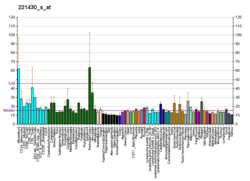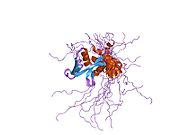| RNF146 |
|---|
 |
| Available structures |
|---|
| PDB | Ortholog search: PDBe RCSB |
|---|
| List of PDB id codes |
|---|
2D8T, 3V3L |
|
|
| Identifiers |
|---|
| Aliases | RNF146, dJ351K20.1, ring finger protein 146 |
|---|
| External IDs | OMIM: 612137; MGI: 1915281; HomoloGene: 12227; GeneCards: RNF146; OMA:RNF146 - orthologs |
|---|
| Gene location (Human) |
|---|
 | | Chr. | Chromosome 6 (human)[1] |
|---|
| | Band | 6q22.33 | Start | 127,266,726 bp[1] |
|---|
| End | 127,288,567 bp[1] |
|---|
|
| Gene location (Mouse) |
|---|
 | | Chr. | Chromosome 10 (mouse)[2] |
|---|
| | Band | 10|10 A4 | Start | 29,220,172 bp[2] |
|---|
| End | 29,238,438 bp[2] |
|---|
|
| RNA expression pattern |
|---|
| Bgee | | Human | Mouse (ortholog) |
|---|
| Top expressed in | - cerebellar vermis
- cerebellar hemisphere
- right hemisphere of cerebellum
- Skeletal muscle tissue of rectus abdominis
- gastric mucosa
- tibia
- biceps brachii
- middle temporal gyrus
- tendon
- body of uterus
|
| | Top expressed in | - interventricular septum
- motor neuron
- Region I of hippocampus proper
- cumulus cell
- superior cervical ganglion
- vestibular sensory epithelium
- primitive streak
- trigeminal ganglion
- vestibular membrane of cochlear duct
- medial ganglionic eminence
|
| | More reference expression data |
|
|---|
| BioGPS |  | | More reference expression data |
|
|---|
|
| Gene ontology |
|---|
| Molecular function | - zinc ion binding
- protein binding
- metal ion binding
- ubiquitin-protein transferase activity
- poly-ADP-D-ribose binding
- ubiquitin protein ligase activity
- transferase activity
| | Cellular component | - cytoplasm
- cytosol
- nucleus
- nucleoplasm
- plasma membrane
| | Biological process | - positive regulation of canonical Wnt signaling pathway
- protein K48-linked ubiquitination
- protein ubiquitination
- protein autoubiquitination
- ubiquitin-dependent protein catabolic process
- Wnt signaling pathway
| | Sources:Amigo / QuickGO |
|
| Orthologs |
|---|
| Species | Human | Mouse |
|---|
| Entrez | | |
|---|
| Ensembl | | |
|---|
| UniProt | | |
|---|
| RefSeq (mRNA) | NM_001242844
NM_001242845
NM_001242846
NM_001242847
NM_001242848
|
|---|
NM_001242849
NM_001242850
NM_001242851
NM_001242852
NM_030963 |
| |
|---|
NM_001110196
NM_001110197
NM_001110198
NM_001284279
NM_026518 |
|
|---|
| RefSeq (protein) | NP_001229773
NP_001229774
NP_001229775
NP_001229776
NP_001229777
|
|---|
NP_001229778
NP_001229779
NP_001229780
NP_001229781
NP_112225 |
| |
|---|
NP_001103666
NP_001103667
NP_001103668
NP_001271208
NP_080794 |
|
|---|
| Location (UCSC) | Chr 6: 127.27 – 127.29 Mb | Chr 10: 29.22 – 29.24 Mb |
|---|
| PubMed search | [3] | [4] |
|---|
|
| Wikidata |
| View/Edit Human | View/Edit Mouse |
|

 1ujr: Solution structure of WWE domain in BAB28015
1ujr: Solution structure of WWE domain in BAB28015 2d8t: Solution structure of the RING domain of the human RING finger protein 146
2d8t: Solution structure of the RING domain of the human RING finger protein 146





















